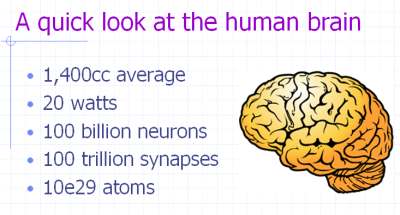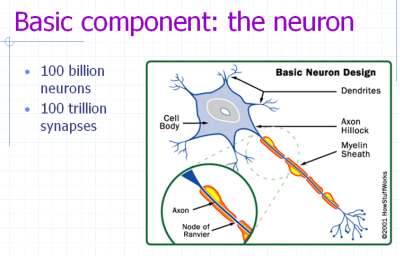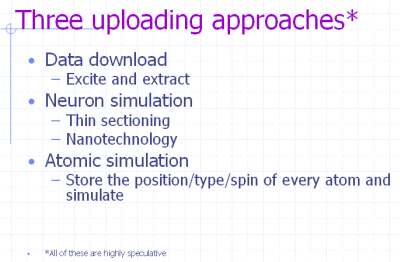How Uploading Works
Marshall Brain
Page 3 of 3
What is going to happen? You can imagine me trying to get through airport security with a toy brain in a soda bottle. It’s a fake brain. It’s a toy and I actually brought the little packaging so I could show them it was just a toy brain.
This is what the next phase of technology will be, I think. I don’t think we’ll get to uploading fast enough. I think we will instead just discard our bodies, take our brain, and put them in containers that provide oxygen, nutrients, antibiotics and whatever else to keep us going. Then later we’ll get to uploading.
The advantage to putting our brains in bottles is, first of all, we eliminate the whole trauma thing from falling down and getting in car wrecks and stuff. Next, there will be far less disease exposure because, it can be kept in a sterile facility and our bodies open us up to lots of diseases that our brains don’t necessarily have to participate in.
The problem is that we will connect to virtual environments by living in bottles and have a lot more fun but the neurons still die. The estimate is about 30 million of your neurons die every year as you go through life.
We are going to want to store our brain in a permanent medium. That is where this whole idea of mind uploading [1] comes from. Back up our consciousness and run it on another medium where we don’t have 30 million neurons dying every year.
Here are the basic facts on the brain, it’s a liter and a half, it consumes 20 watts, it has 100 billion neurons, 100 trillion synapses, it’s got a lot of atoms, maybe ten to the thirtieth atoms and it uses this basic component called a neuron, for its technology.
 Image 6: Human Brain
Image 6: Human Brain
The problem is how do you store this and then execute it in some other medium besides the current one? How do we take the patterns that are in it? The patterns are stored in at least three ways: the connections between the neurons, the formation of new synapses through experiences and then, microtubules.
 Image 7: The Neuron
Image 7: The Neuron
Memory could be stored somehow but I don’t think we even know how all memories are stored. We somehow take all that physiology, put it into some kind of computer medium, and then we have to figure out how to execute it, which may happen in two steps.
There are maybe ten to twenty different commonly discussed possible ways to do this. One is where they take the top of your skull off and they just probe your cortex with an electrode and you get really vivid memories of things that have happened in your life. Those memories play on your visual cortex and there are memories that play on your auditory cortex. So, one idea is to somehow probe the brain, basically scan through it memory by memory, and record images and sounds off the visual and auditory, and record it. That would be low fidelity but it would be a way of capturing the movies out of your brain.
The second way is neuron simulation of some sort. You have to somehow get inside the brain, probably destructively, and look at every single neuron and see how is it connected to all the other neurons around it, how are the synapses weighted, how are the synapses connected, and somehow tease that out of the structure.
 Image 8: Uploading Approaches
Image 8: Uploading Approaches
The two main ways of doing that have been proposed is either slicing the brain very gently and just scanning it in some way or injecting some kind of a nanotechnology entities into it that can look at and figure out how to emulate each neuron and either kill off that neuron and replace it, as that opportunity is available, or somehow stand alongside it and eventually have an image of every neuron in the whole brain that’s being transmitted out by these nanobots.
Or, you go the whole distance and you somehow look at every single atom in this object and you store the type of atom, its location, it’s bonding to neighboring atoms, someone mentioned (cork spin), and somehow take an atomic image of this.
Then the question is: how would you do that? No one has a really good idea right now but this Star Trek transporter room idea does offer one technology for doing that because it is already taking your entire body and turning it into an electromagnetic wave that can be transmitted to a planet surface.
That gives you an example of how speculative the technology is. No one has a good way of conceiving of how you would take something apart atom by atom and then simulating it into the atomic level and running it.
The thing that is so interesting is that all of these things are probably possible, perhaps within 40 years. In some form of this in some way within 40 years, that’s extremely hard to imagine, yet probably true in the same way. Going from the Wright Brothers’ airplane to the B-52 was hard to imagine in 50 years.
I think back to that nice woman who was sitting on the airplane with me. In perhaps 40 years, that problem won’t exist anymore. That is an amazing thing if it actually happens.
Footnote
[1]. Mind Transfer/Mind Uploading - In transhumanism and science fiction, mind transfer (also referred to as mind uploading or mind downloading, depending on one's point of reference), whole body emulation, or electronic transcendence refers to the hypothetical transfer of a human mind to an artificial substrate. Wikipedia.org January 23, 2007 3:47PM EST
 Marshall Brain, founder How Stuff Works
Marshall Brain, founder How Stuff Works
Marshall Brain is a well-known national speaker and consultant. Best known as the founder of How Stuff Works, he has also authored several books including, the Robotic Nation essays, the book Manna, and a book for teenagers entitled The Teenager's Guide to the Real World, now in its eighth printing and selected for the New York Public Library's prestigious Books for the Teen Age list. He is a member of the Academy of Outstanding Teachers at North Carolina State University, where he taught in the computer science department for 6 years.